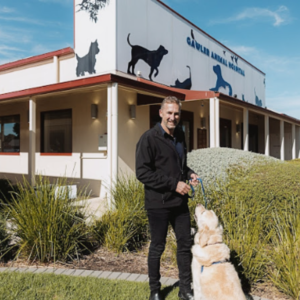As always, we endeavour to improve the way we treat our pet patients and to incorporate the latest research findings. As part of our ongoing Continuing Education program, three of our staff members have just returned from the Gold Coast where they attended the Australian Small Animal Veterinarians conference. This was held in conjunction with the respective veterinary groups of our Asia-Pacific neighbours and attracted an international audience. The treatment of arthritic pain was one of the major topics covered.
Dr Alyssa and nurses Jo and Renee came away with confirmation that we are already providing a very high level of care for our arthritic patients. They also picked up a few tips and tricks, however, and we’ll be implementing some of these innovations into our treatment regime for pets. The following press release from the Australian Veterinary Association touches on some aspects of arthritic pain management and I thought it was worth passing on this information to help keep your dogs and cats as comfortable as possible.
Media Release
16 August 2017
Managing joint pain in dogs and cats
Arthritis is a human condition that our furry friends sadly also suffer from, especially as they grow older. Hosted by Australian Small Animal Veterinarians (ASAV), a special interest group of the Australian Veterinary Association, the FASAVA Congress is for veterinarians in the Asia Pacific region who predominantly treat pets. This weekend, small animal surgery specialist, Dr Stephen Fearnside, will discuss the options that are available here and now and what the future might hold to help manage chronic pain in Aussie family pets.“A significant proportion of the pet population suffers from osteoarthritis. As medical advancements continue, our patients live longer and as a result the number of patients we see with chronic diseases such as osteoarthritis will increase and will require management.“Fortunately, we’ve become better at recognising the problem and there are plenty of management options for veterinarians to investigate and use,” Dr Fearnside said.When managing patients with osteoarthritis, veterinarians look to address three key issues:
- reducing pain
- improving mobility and quality of life
- slowing disease progression.
“Rehabilitation and physiotherapy are playing an increasing role in the multi-modal management of chronic pain in dogs and cats.“Therapies such as massage, joint mobilisation, stretching and targeted exercise programs have become increasingly used in the management of osteoarthritis. Other therapies such as cold laser and therapeutic ultrasound are also being investigated,” Dr Fearnside said.It’s well understood that obesity plays an important role in contributing to the progression and development of osteoarthritis. Dr Fearnside says that pet owners should discuss weight management strategies with their veterinarian in the effort to combat the disease.“It’s very hard for pet owners to see their animals suffering and in pain. Providing pets with a healthy and active lifestyle, a nutritious diet, and a preventative health care plan formulated in consultation with a veterinarian gives them the best chance of living long and happy lives.“While a cure for osteoarthritis is not yet in sight, we do have many management options available to us in our effort to reduce pain and improve the quality of life of our pets suffering with the disease,” he said.The AVA recommends that pet owners speak to their veterinarian about their pet’s mobility and joint health..
As always, if you’d like to see us regarding pain management or arthritis, please give our lovely receptionists a call or book directly online.






